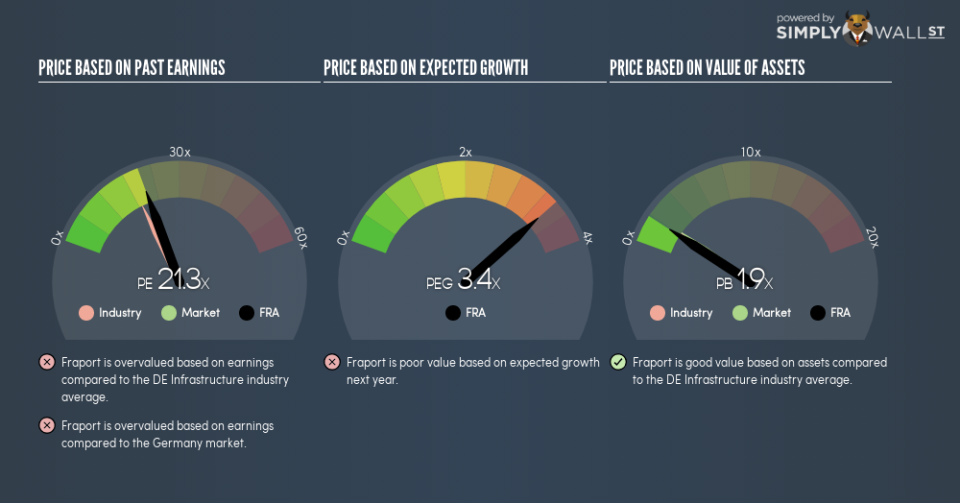Is Fraport AG (ETR:FRA) Attractive At This PE Ratio?

I am writing today to help inform people who are new to the stock market and want to start learning about core concepts of fundamental analysis on practical examples from today’s market.
Fraport AG (ETR:FRA) trades with a trailing P/E of 21.3, which is higher than the industry average of 18.9. While this might not seem positive, it is important to understand the assumptions behind the P/E ratio before you make any investment decisions. In this article, I will explain what the P/E ratio is as well as what you should look out for when using it.
See our latest analysis for Fraport
Demystifying the P/E ratio
The P/E ratio is a popular ratio used in relative valuation since earnings power is a key driver of investment value. It compares a stock’s price per share to the stock’s earnings per share. A more intuitive way of understanding the P/E ratio is to think of it as how much investors are paying for each dollar of the company’s earnings.
P/E Calculation for FRA
Price-Earnings Ratio = Price per share ÷ Earnings per share
FRA Price-Earnings Ratio = €77.74 ÷ €3.642 = 21.3x
On its own, the P/E ratio doesn’t tell you much; however, it becomes extremely useful when you compare it with other similar companies. Our goal is to compare the stock’s P/E ratio to the average of companies that have similar attributes to FRA, such as company lifetime and products sold. One way of gathering a peer group is to use firms in the same industry, which is what I’ll do. Since FRA’s P/E of 21.3 is higher than its industry peers (18.9), it means that investors are paying more for each dollar of FRA’s earnings. This multiple is a median of profitable companies of 5 Infrastructure companies in DE including EUROKAI GmbH KGaA, Hopewell Highway Infrastructure and Abertis Infraestructuras. You could also say that the market is suggesting that FRA is a stronger business than the average comparable company.
A few caveats
However, you should be aware that this analysis makes certain assumptions. The first is that our “similar companies” are actually similar to FRA. If not, the difference in P/E might be a result of other factors. For example, if Fraport AG is growing faster than its peers, then it would deserve a higher P/E ratio. Of course, it is possible that the stocks we are comparing with FRA are not fairly valued. So while we can reasonably surmise that it is optimistically valued relative to a peer group, it might be fairly valued, if the peer group is undervalued.
What this means for you:
If your personal research into the stock confirms what the P/E ratio is telling you, it might be a good time to rebalance your portfolio and reduce your holdings in FRA. But keep in mind that the usefulness of relative valuation depends on whether you are comfortable with making the assumptions I mentioned above. Remember that basing your investment decision off one metric alone is certainly not sufficient. There are many things I have not taken into account in this article and the PE ratio is very one-dimensional. If you have not done so already, I highly recommend you to complete your research by taking a look at the following:
Future Outlook: What are well-informed industry analysts predicting for FRA’s future growth? Take a look at our free research report of analyst consensus for FRA’s outlook.
Past Track Record: Has FRA been consistently performing well irrespective of the ups and downs in the market? Go into more detail in the past performance analysis and take a look at the free visual representations of FRA’s historicals for more clarity.
Other High-Performing Stocks: Are there other stocks that provide better prospects with proven track records? Explore our free list of these great stocks here.
To help readers see past the short term volatility of the financial market, we aim to bring you a long-term focused research analysis purely driven by fundamental data. Note that our analysis does not factor in the latest price-sensitive company announcements.
The author is an independent contributor and at the time of publication had no position in the stocks mentioned. For errors that warrant correction please contact the editor at editorial-team@simplywallst.com.

